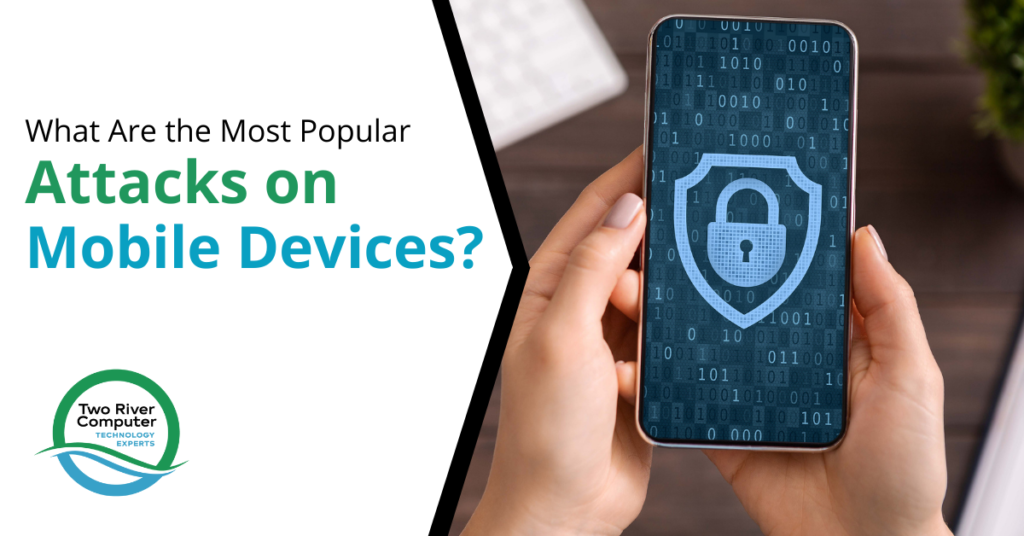
Mobile devices have surpassed computers for both consumer and business use. It’s estimated that 60% of all online searches happen from a mobile device and smartphone use makes up 80% of social media browsing.
The workplace has also seen more of the workload transition to mobile devices, which people use for checking email and accessing business apps. A Microsoft report emphasizes that mobile devices are now the dominant device used for work, taking on more than 80% of the work during a typical day.
This shift is due to the mobility and convenience offered by tablets and smartphones, but that popularity has also brought risk.
Mobile devices tend to be less protected than computers and servers because it’s only recently that they were seen as more than just a way to communicate. Smartphones, tablets, and wearables (like Apple Watch) now have access to all the same types of apps and data as your computer. This includes everything from your online bank application to your Instagram and Facebook data.
In 2020, 46% of organizations had at least one employee download a malicious mobile application. Without proper device security, one employee’s smartphone can cause an entire company network to be breached.
The first step in protecting your mobile device from an attack is knowing the types of threats that are most prevalent. Here is a rundown of the most popular mobile device attacks.
Smishing (Phishing via SMS)
A lot of people have learned over the years to be wary of emails that look strange or that come from an unexpected source. However, they have not yet built up this same awareness for phishing coming in via SMS.
Just think about how many retailer, medical office, or shipping notification text messages you get per month. It’s likely a lot more than just a few years ago. In an effort to avoid having messages lost in email inboxes, retailers have begun encouraging customers to sign up for SMS alerts.
This may be helpful to know the latest sale, but it also makes it easier for phishing scammers to slip in a fake text message with a malicious link. It won’t be long before phishing via SMS will outpace email phishing.
Mobile Malware Hidden in Apps
Mobile malware is another big threat to network and device security. People often look for new and interesting apps and can easily be lured by the promise of a free app.
While the app stores work to keep malicious apps out, they can still end up being found there for weeks before being removed. The unsuspecting phone user will download the free app, and the app may even do what it says. But malware will be infecting the device in the background, potentially stealing all information found on the device or cloning the SIM card.
An average of 24,000 malicious mobile apps are blocked every day by the various mobile app stores.
Man-in-the-Middle Attacks Through Public Wi-Fi
Another way that mobile devices are targeted is through man-in-the-middle attacks. This is when a hacker is on public Wi-Fi and uses software to breach the information of others using the same public wireless connection.
Unsecured Wi-Fi, either public or home Wi-Fi, can make it easy for a hacker to gain control of another device and then through that device connect to data and sensitive information.
It’s important to use a VPN app when on public Wi-Fi or turn off the Wi-Fi and use your mobile carrier’s connection before inputting any type of data or even checking email.
Firmware Attacks Through New Wearables
People can now check email and access personal and business mobile apps through things like an Apple Watch or other types of wearable devices. These IoT devices are huge targets for hackers because they often have a barrier between the firmware and operating system, which obscures firmware level attacks.
This means that users have a hard time knowing if their device has been breached due to the limited visibility. These devices are also so new that they often don’t have the same cybersecurity safeguards available as other mobile devices.
Taking Advantage of a Gap in End-to-End Encryption
Hackers love plain text communications, such as unencrypted email or messages through a non-secure app.
Gaps in end-to-end encryption of data are another vulnerability that criminal groups will take advantage of. One break in the chain can allow them to steal sensitive information or user login credentials for a cloud application or website.
Schedule a Mobile Security Checkup Today!
Don’t leave your network and device vulnerable to a mobile device breach. Two River Computer can help Fair Haven businesses and residents with a mobile security checkup to help you better secure your personal or business data.
Contact us today for a free consultation. Call 732-747-0020 or reach us online.


